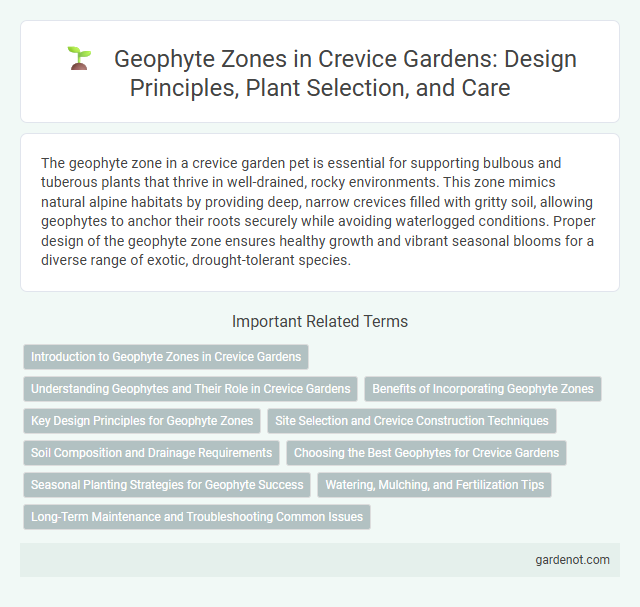The geophyte zone in a crevice garden pet is essential for supporting bulbous and tuberous plants that thrive in well-drained, rocky environments. This zone mimics natural alpine habitats by providing deep, narrow crevices filled with gritty soil, allowing geophytes to anchor their roots securely while avoiding waterlogged conditions. Proper design of the geophyte zone ensures healthy growth and vibrant seasonal blooms for a diverse range of exotic, drought-tolerant species.
Introduction to Geophyte Zones in Crevice Gardens
Geophyte zones in crevice gardens highlight areas specifically designed to accommodate bulbs and tuberous plants that survive underground during dormancy. These zones ensure optimal drainage, mimicking natural rocky habitats where geophytes thrive, enabling seasonal growth cycles and vibrant spring blooms. Proper soil composition and microclimate control within the crevices support the unique physiological needs of these plants.
Understanding Geophytes and Their Role in Crevice Gardens
Geophytes are perennial plants that survive adverse seasons through underground storage organs such as bulbs, corms, or tubers, making them ideal for the Geophyte zone in crevice gardens. Their deep-rooted adaptations allow them to thrive in narrow rock fissures by accessing moisture and nutrients unavailable to surface plants. Incorporating geophytes enhances biodiversity and seasonal interest in crevice gardens by providing early spring blooms and resilient foliage.
Benefits of Incorporating Geophyte Zones
Incorporating geophyte zones in a crevice garden enhances biodiversity by supporting a wide range of bulbous plants such as crocuses, snowdrops, and fritillaries, which thrive in well-drained, nutrient-rich crevices. These zones improve seasonal interest through vibrant spring blooms and foster natural pollinator activity, boosting ecological balance. Furthermore, geophyte zones contribute to soil aeration and moisture regulation, promoting overall garden health and resilience against environmental stress.
Key Design Principles for Geophyte Zones
Geophyte zones in crevice gardens emphasize deep, well-drained soil layers to accommodate bulbs and tubers, ensuring optimal root development and moisture control. Incorporating stratified soil pockets mimics natural habitats, facilitating seasonal growth cycles and dormancy periods essential for geophytes' survival. Positioning plants in sunlit crevices enhances photosynthesis and flowering, while materials such as gravel and sandstone improve drainage and microclimate regulation.
Site Selection and Crevice Construction Techniques
Selecting a suitable site for the geophyte zone in a crevice garden requires well-drained, sun-exposed areas with minimal wind to mimic natural alpine conditions. Crevice construction techniques involve stacking flat stones vertically to create deep, narrow fissures that provide excellent root drainage and protection for geophytes. Incorporating varied stone sizes and orientations enhances microclimates within the crevices, promoting healthy growth and seasonal flowering of bulbous plants.
Soil Composition and Drainage Requirements
The Geophyte zone in a crevice garden requires well-drained, gritty soil composed of a mix of sand, gravel, and organic matter to mimic natural rocky habitats. This soil composition promotes rapid drainage and prevents waterlogging, critical for geophytes that store nutrients in underground bulbs or tubers. Proper drainage minimizes root rot risk and supports healthy growth cycles tailored to seasonal moisture variations.
Choosing the Best Geophytes for Crevice Gardens
Selecting the best geophytes for crevice gardens involves prioritizing species with compact growth habits and robust root systems that thrive in well-drained, rocky environments. Bulbs such as crocuses, scillas, and fritillarias are ideal for their adaptability to narrow soil pockets and resistance to drought. Emphasizing native geophytes enhances ecological harmony and ensures better survival rates in the microclimate unique to crevice gardens.
Seasonal Planting Strategies for Geophyte Success
Seasonal planting strategies for geophytes in the crevice garden emphasize timing bulb planting in the fall to ensure robust spring blooms and adequate root development. Selecting geophyte species adapted to local climate zones optimizes growth cycles and drought resistance in narrow soil pockets. Incorporating mulch and precise watering regimes during dormancy periods supports nutrient retention and reduces stress in the geophyte zone.
Watering, Mulching, and Fertilization Tips
In the geophyte zone of a crevice garden, consistent watering is essential to mimic natural conditions, ensuring bulbs remain moist but not waterlogged. Applying a layer of mulch helps retain soil moisture and regulate temperature, promoting healthy root development. Fertilize with a balanced, slow-release fertilizer in early spring to support vigorous growth and flowering throughout the season.
Long-Term Maintenance and Troubleshooting Common Issues
The geophyte zone in a crevice garden requires minimal irrigation and well-drained soil to prevent bulb rot, ensuring longevity and thriving growth of species like crocus and fritillaria. Regular inspection for pests such as bulb mites and fungal infections is critical to avoid damage, while removing dead foliage prevents disease spread. Mulching with porous materials supports moisture balance and temperature regulation, reducing long-term maintenance challenges in this specialized garden zone.
Geophyte zone Infographic

 gardenot.com
gardenot.com